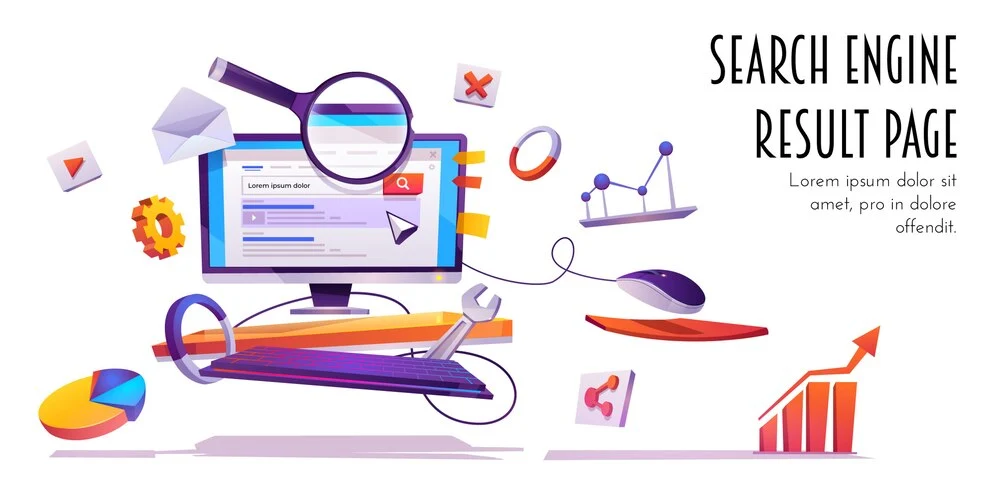
SERPs stand for search engine results pages. Web pages known as search engine results pages are displayed to users when they use a search engine, like Google, to look for anything online. After entering their search query, which frequently includes specific terms and phrases known as keywords, the user is presented with a search engine results page (SERP). These are the best, most pertinent results for the search query, including paid advertisements and organic pages.
Even when the same terms or search queries are used on the same search engine, each SERP is different. This is due to the fact that almost every search engine tailors the user experience by displaying results depending on a variety of variables other than the user's search keywords, including the user's location, browsing history, and social settings. Additionally, as new content is added to the internet and search engines modify their algorithms, search rankings are always changing. Even though two SERPs could look the same and have many of the same results, they frequently have minor variations.
How does SERP work?
Because Google, Bing, and other search engine providers attempt to give their consumers a more responsive and transparent experience, the look of search engine results pages is always changing. Because of this, as well as new and constantly changing technologies in the search industry, today's SERPs seem very different from their predecessors.
Organic SERP Rankings
The two primary types of material that show up within SERPs are "organic" results and "paid " results. Listings of websites derived by the search engine's algorithm are known as organic results (more on this in a moment). SEOs, or search engine optimization specialists, are experts at improving websites and web content so they show higher in natural search results.
Most of those results that are highlighted in the following figure are organic:

The box on the right side of this SERP is known as the Knowledge Graph, or Knowledge Box. In order to provide succinct solutions to frequently asked queries in a single, central position on the search engine results page (SERP), Google implemented this feature in 2012. Here, you may view a wealth of information about Abraham Lincoln, including his birthdate and place, height, assassination date, political affiliation, and child names. Many of these facts have links to the pages that contain the pertinent information.
More organic results will appear in some SERPs than others, such as the one above. This is because different searches have different goals.
Three main categories of Internet searches exist:
Transactional, Navigational, and Informational
Users who want to learn more about a certain subject, like Abraham Lincoln, conduct informational searches. Since the search term "Abraham Lincoln" has very little commercial intent—the great majority of users are not looking to purchase anything—it would be counter productive to place advertisements or other paid results on a SERP like this. Instead, only informative results are shown on the SERP.
Those that aim to find a particular website through a search are known as navigational questions. This could be the case when someone is looking for a particular website, attempting to find a website whose URL they can't remember, or achieving another kind of navigational goal.
Last but not least, the SERP is most likely to provide paid results for transactional searches. Search queries that result in transactional SERPs may contain phrases like "buy" and other terms that imply a strong desire to make a purchase, indicating that transactional searches have a high level of commercial intent.
Paid SERP Results
Paid results are those that an advertiser has paid to display, as opposed to organic results. Small, text-based advertisements that were usually shown above and to the right of the organic results were the only kind of paid results available in the past. However, there are now hundreds of advertising formats that meet the objectives of advertisers, and paid results can take many different shapes.
With the exception of the map and company listing underneath it, every result on the SERP for the search term "lawn mowers" in the example above is a sponsored result. Typical PPC campaigns are the three large text-based advertising at the top of the SERP, which are seen by advertisers as premium positioning. The lower two of these three advertisements (for Craftsman.com and Husqvarna.com) both include ad extensions that let potential buyers go straight from the advertising to particular pages on their websites.
Shopping ads, a component of the Google Ads platform that enables product information from e-commerce merchants to appear alongside other results on the SERP, are the image-based advertisements on the right side of the page. A variety of information, including product availability, user reviews, exclusive deals, and more, can be found in shopping advertisements.
Search Engines and Ranking Signals
Listings that have been indexed by the search engine using a variety of criteria, also referred to as "ranking signals," are called organic results.
For instance, Google's search algorithm has hundreds of ranking variables, some of which are deemed more significant than others, though no one outside of Google is sure exactly what they are. A site's link profile, or the quantity of external connections pointing to a particular website like www.digitechip.com (website designing company in Delhi) or web page from Digitechip websites, used to be a significant ranking indicator.To some extend, it still is (which explains why Wikipedia appears so highly in organic results for so many queries), but search technology is developing so quickly that ranking signals that were once essential to the search algorithm may no longer be as significant, which constantly irritates SEOs.
How to optimize for SERP features
Businesses and marketers must optimize for SERP characteristics if they want to boost their online presence, attract more customers, and raise their search engine ranks. The following advice can help you optimize for SERP features:
Optimization of content
In order to rank higher in search engine results pages (SERPs), content optimization entails producing and improving content. The following advice will help you optimize your content for SERP features:
- Employ targeted and relevant keywords: Include keywords that are relevant to both your target market and your company.
- Provide valuable and captivating material: Produce content that is both valuable to your target audience and of a high caliber.
- Optimize Your Meta Tags: Make sure all of your meta tags are optimized, including your title, description, and keyword tags.
- Use template markup: Use schema markup to provide search engines with more detail about your content.
- Make your photos better: To improve your photos, use informative and pertinent alt tags and file names.
